Auteur/autrice : C&A HD
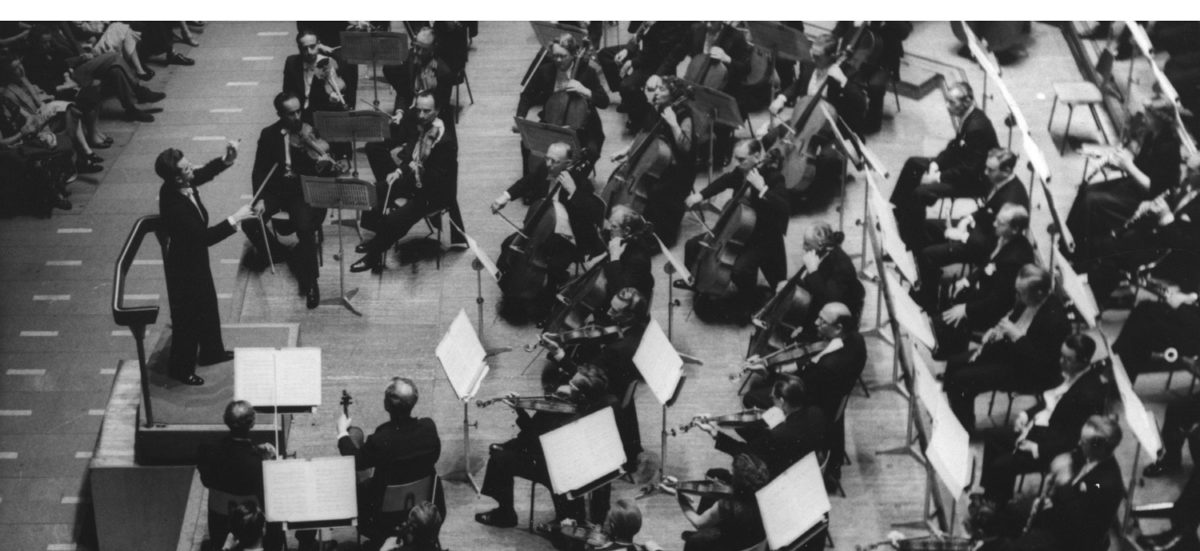
Guido Cantelli
Source: Bande/Tape 19 cm/s / 7.5 ips
I – Philharmonia Orchestra – London Kingsway Hall May 15 & 21, 1953
Manoug Parikian, violin
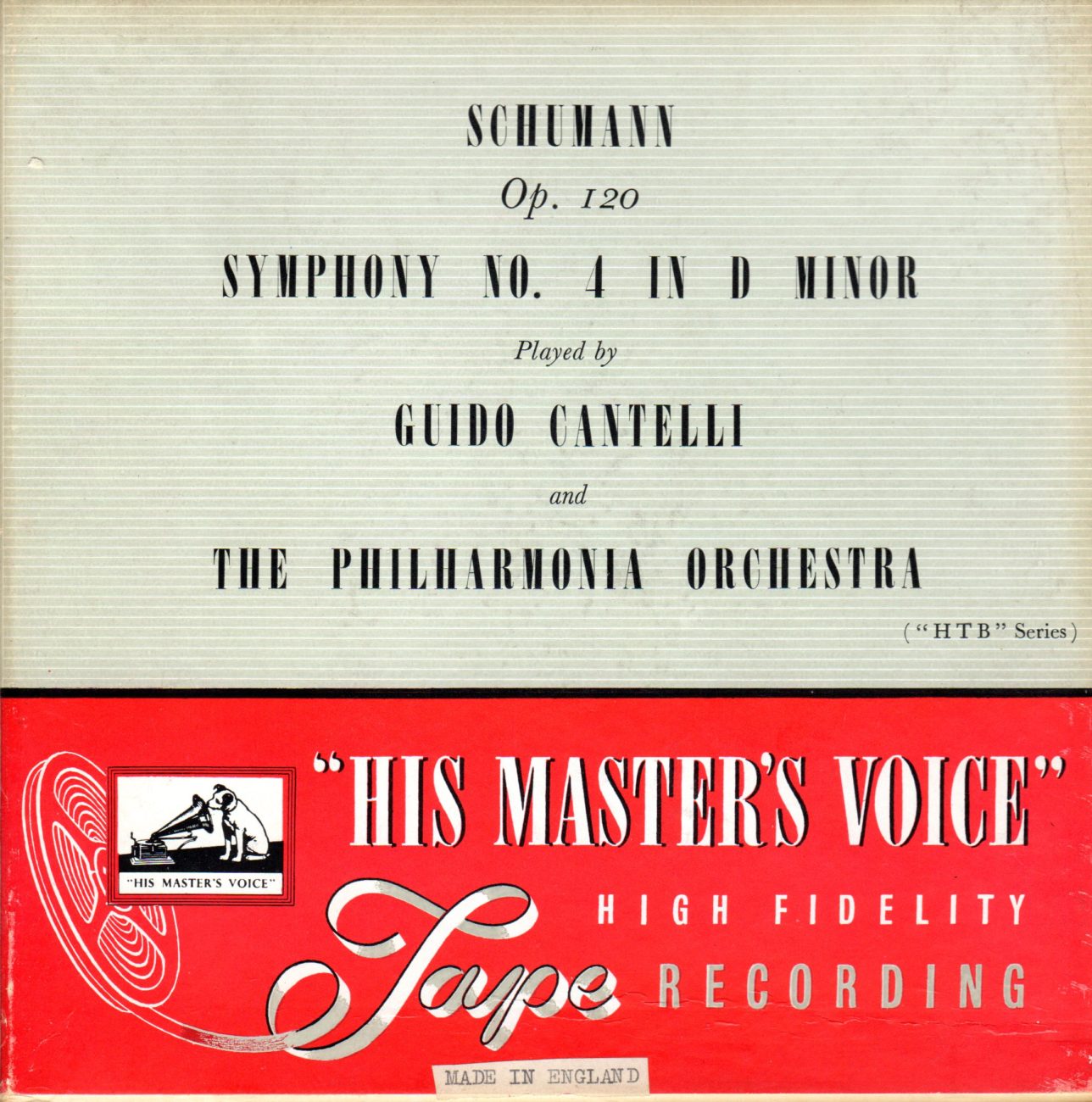


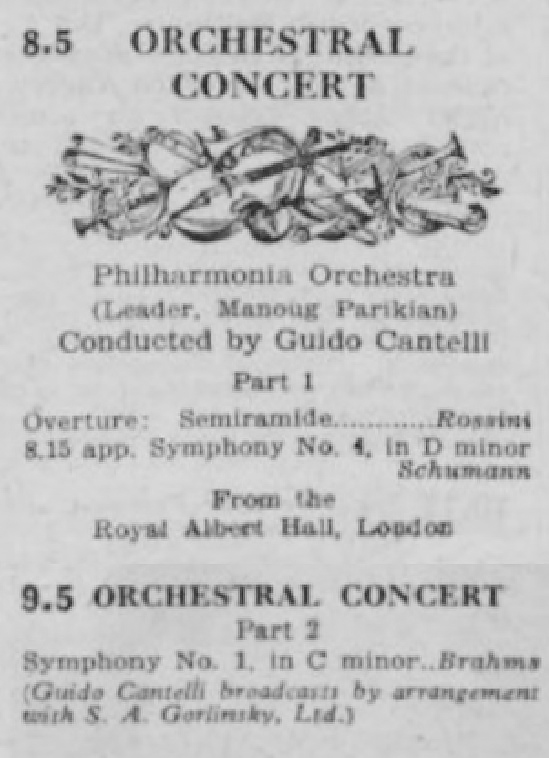
Concert du 11 mai 1953 (BBC Third Program)
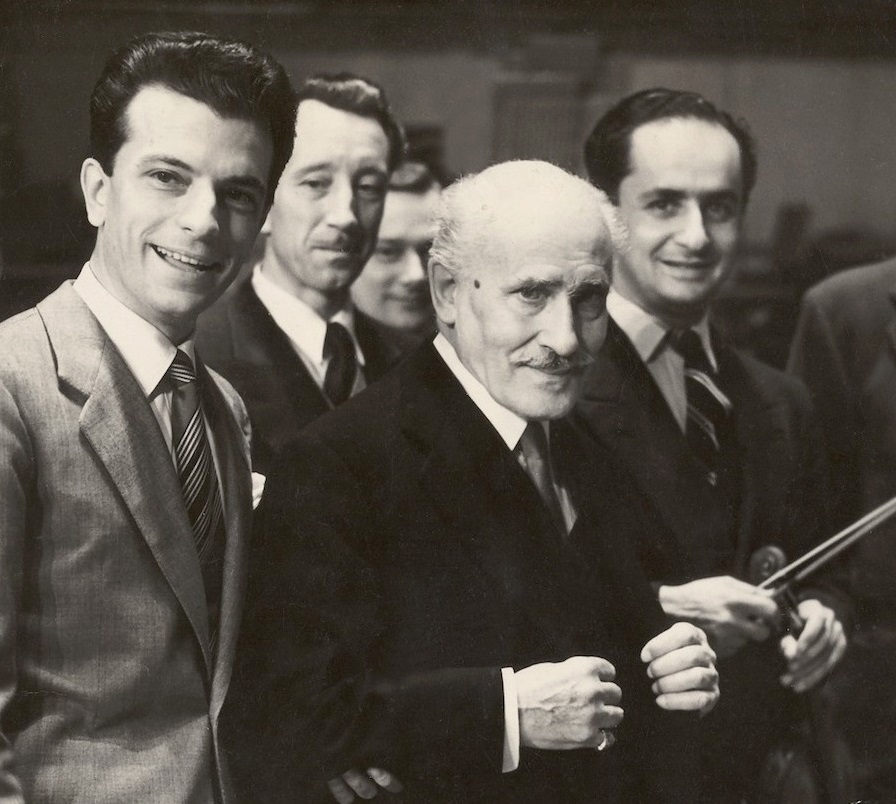
Guido Cantelli Herbert Downes Arturo Toscanini Manoug Parikian
La Quatrième de Schumann: une des grandes interprétations de Guido Cantelli. Son enregistrement avec le Philharmonia, réalisé peu après un concert au Royal Albert Hall (et quasiment en même temps que celui de Furtwängler), est ici reproduit à partir d’un exemplaire en bon état de la bande commercialisée sous la référence HTB 401. Quant à la version en public avec le NYPO, elle matérialise la seule série de concerts où il l’a programmée avec cet orchestre, et aussi son ultime vision de cette œuvre, assez différente de celle avec le Philharmonia, mais tout aussi passionnante.
____________
Schumann Symphonie n°4 – Cantelli Concerts (* = concert radiodiffusé/broadcast concert):
Orchestra del Teatro alla Scala: 12/11/ 1954 (Brescia); NBC SO: 29/11/1952*; NYPO: 15, 16, 18*, 24/3/1956; BSO: 6, 7*/2/1953; WPO: 9/8/1953* (Salzburg); Philharmonia: 11/5/1953* (CD ICAC 5143); 9/9/1954* Edinburgh (CD ICAC 5081)
____________
The Schumann Fourth: one of the great interpretations by Guido Cantelli. His recording with the Philharmonia, made soon after a concert at Royal Albert Hall (and almost at the same time as Furtwängler’s), is reproduced here from a copy in good condition of the HTB 401 commercial tape. As to the live version with the NYPO, it materializes the only concert week when he performed it with this orchestra, and also his last vision of this work, rather different from the one with the Philharmonia, but as thrilling.
II – NYPO New York Carnegie Hall – March 18, 1956
John Corigliano, violin
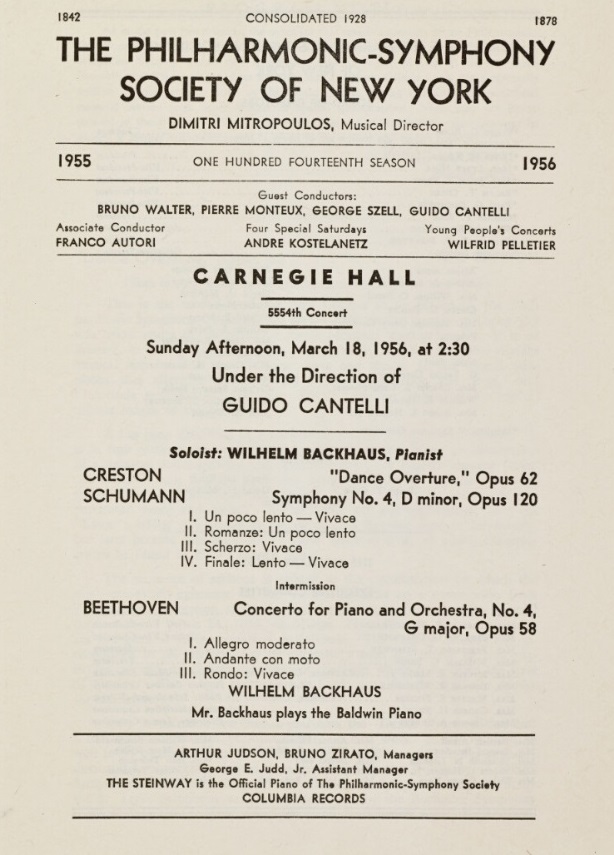
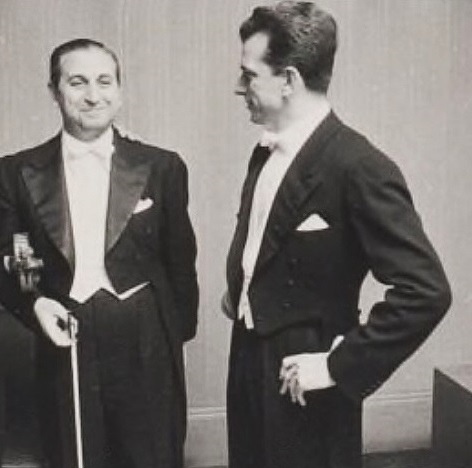
John Corigliano Guido Cantelli
Les liens de téléchargement sont dans le premier commentaire. The download links are in the first comment.
A l’occasion du 125ème Anniversaire de la naissance de Charles Panzéra
Charles Panzéra, baryton – Magdeleine Panzéra-Baillot, piano
La Bonne Chanson Op.61 (Paul Verlaine): Une sainte en son auréole – Puisque l’aube grandit – La lune blanche luit dans les bois – J’allais par des chemins perfides – J’ai presque peur en vérité – Avant que tu ne t’en ailles – Donc ce sera par un clair jour d’été – N’est-ce pas? – L’hiver a cessé
Paris Studios Albert – 30 septembre & 1er octobre 1936
__________
Quatre Mélodies (Paul Verlaine): En sourdine Op58 n°2* – C’est l’extase Op58 n°5 – Clair de lune Op46 n°2** – Spleen Op51 n°3
10 Mélodies: Chanson du pêcheur Op4 n°1 (Théophile Gautier) – Aurore Op39 n°1 (Armand Silvestre) – Les Berceaux Op23 n°1 (Sully Prudhomme) – Lydia Op4 n°2 (Leconte de Lisle)** – Automne Op18 n°3 (Armand Silvestre) – Nocturne Op43 n°2 (Villiers de l’Isle Adam) – Soir Op83 n°2 (Albert Samain) – Après un rêve Op7 n°1 (Romain Bussine) – Au cimetière Op51 n°2 (Jean Richepin) – Le Parfum impérissable Op76 n°1 (Leconte de Lisle)*
L’Horizon Chimérique Op118 Jean de la Ville de Mirmont): La Mer est infinie – Je me suis embarqué – Diane, Séléné – Vaisseaux, nous vous aurons aimés
Paris Studios Albert: 1933*; 1935**; 1937
33t. Toshiba- EMI GR2034 & GR2162
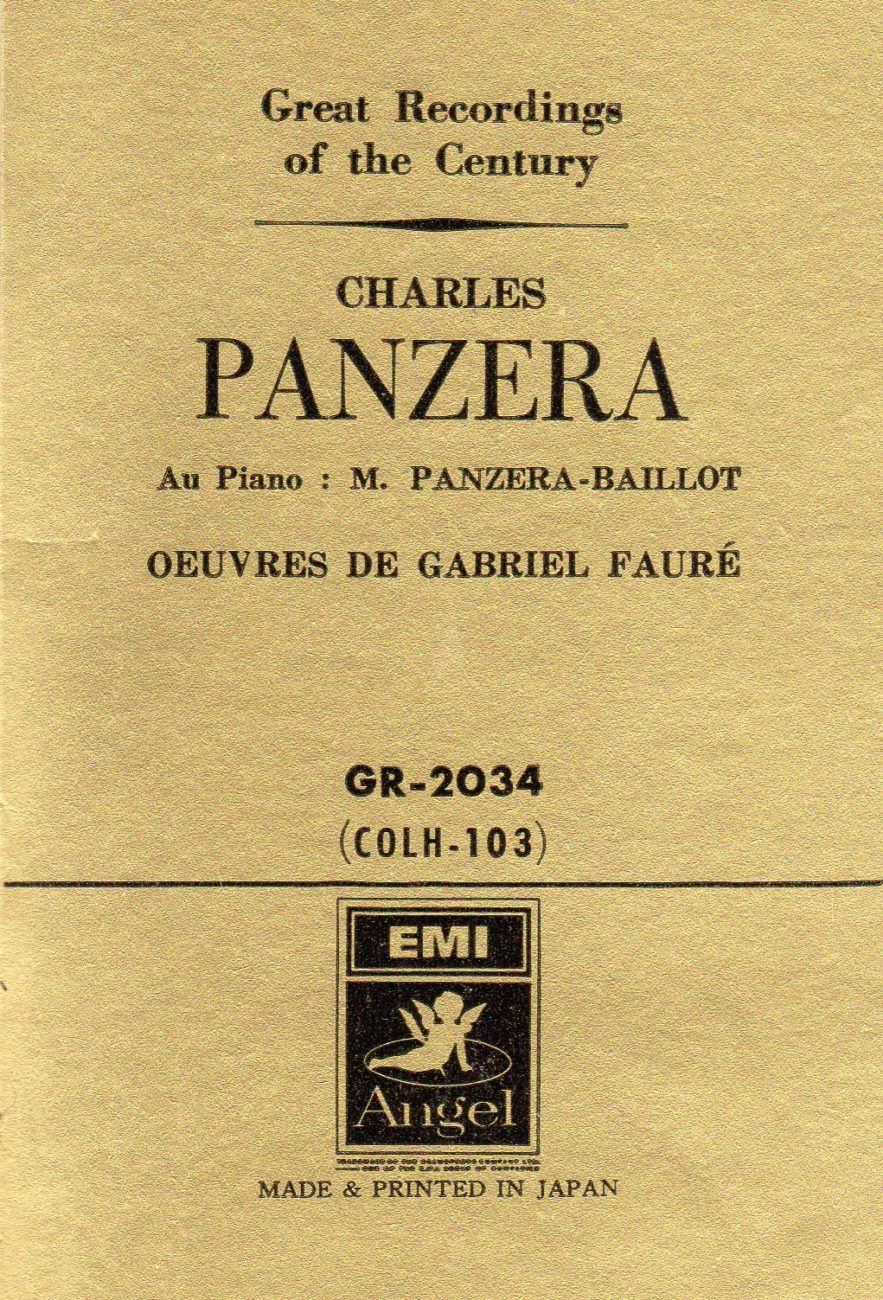
Charles Panzéra (1896-1976) est né à Genève de parents français. Il fait ses études au Conservatoire de Paris, mais elles sont interrompues en 1914 par son incorporation dans l’armée, non sans que Gabriel Fauré ait remarqué son talent hors du commun. Après l’armistice, il obtient son diplôme et débute à l’Opéra-Comique en 1919 où il reste trois saisons. Gabriel Fauré l’oriente vers l’interprétation de la musique vocale, et il lui dédie ses dernières mélodies, le cycle L’Horizon chimérique, composé à l’automne 1921.
Le chant de Panzéra était étonnamment moderne, et dans ses interprétations des mélodies de Gabriel Fauré, avec lequel il a beaucoup travaillé, il a su conjuguer la pureté et le classicisme du style avec la passion dans l’expression, au plus près des souhaits du compositeur. Sa voix possédait d’ailleurs une puissance rarement rencontrée chez les barytons qui chantent la mélodie française. La perfection de sa diction a été analysée par Roland Barthes. De plus, il formait avec son épouse Magdeleine Panzéra-Baillot (1893-1982), qui était une remarquable pianiste, un duo parfaitement intégré.
Il était apprécié des compositeurs de son temps, par exemple Duparc (« tous ceux qui ont eu le bonheur de vous entendre ont emporté du concert un impérissable souvenir »), Honegger (« le meilleur chanteur de mélodies à l’heure actuelle »), ou bien Philippe Gaubert, à la fois compositeur et chef d’orchestre (« Panzéra est certainement le premier chanteur de mélodies à l’heure présente »), sans oublier Furtwängler (« Panzéra est un admirable artiste »).
En décembre 1951, ils ont enregistré deux microsillons MG 10097 & MG 10098 pour la firme Mercury, mais sa voix n’était plus à son sommet. Ces disques sont alors tombés dans un oubli discret et sont même devenus introuvables, ce qui est dommage car on y trouve des pièces pour piano seul ainsi que des œuvres nouvelles dans sa discographie:
MG 10097 – Debussy & Fauré: Debussy: Romance – La grotte – Fêtes Galantes: Le Faune – Colloque sentimental piano solo: Images (1re série): Reflets dans l’eau – Préludes 1er livre: La Cathédrale engloutie & Minstrels/ Fauré: Chanson du pêcheur Op4 n°1 – Lydia Op4 n°2 – Adieu Op21 n°3 – L’Horizon chimérique Op119 piano solo: Barcarolle n°2 Op41
MG 10098: Ravel: Cinq mélodies populaires grecques – Quatre chants populaires piano solo: Jeux d’eau/ Compositeurs français contemporains: Poulenc Priez pour paix – Milhaud Berceuse – Honegger Murcie en fleurs – Trémois Le voyage – Delvincourt Enlèvement en mer – Aubert Les Souliers de l’Avocat (dédié à Panzéra) – Noël-Gallon Chanson du Vieux piano solo: Poulenc Caprice italien – Ropartz Ronde
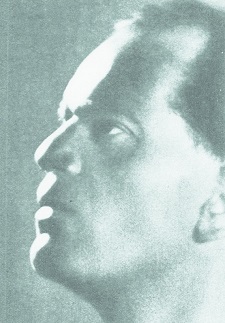

Charles Panzéra (1896-1976) is born in Geneva from French parents. He studies at the Paris Conservatoire, and in 1914, he has to join the Army, but Gabriel Fauré had already spotted his outstanding talent. After the armistice, he obtains his diploma and makes his debut at the Opéra-Comique in 1919 where he remains during three seasons. Gabriel Fauré directs him toward the interpretation of vocal music, and dedicates to him his last melodies, the cycle L’Horizon chimérique, composed in the autumn of 1921.
Panzéra’s singing was astonishingly modern, and in his performances of the melodies by Gabriel Fauré, with whom he has worked a lot, he was able to combine the purity and the classicism of the style with the passion of the expression, closest to what the composer wished. His voice was much larger than the one of the other baritones singing the repertoire of French melodies. How perfectly he mastered the pronunciation of French language has been analysed by Roland Barthes. Morever, he made with his wife Magdeleine Panzéra-Baillot (1893-1982), who was a remarkable pianist, a fully integrated duet.
He was appreciated by compositers of his time, e.g. Duparc (« all those who were lucky to listen to you have taken of the concert an imperishable memory« ), Honegger (« nowadays, the best melody singer« ), or Philippe Gaubert, both composer and conductor (« Panzéra is certainly the first melody singer at the present time« ), without forgetting Furtwängler (« Panzéra is a wonderful artist »).
In December 1951, they recorded two LPs MG 10097 & MG 10098 for Mercury (see above), but his voice was past its prime. Then, these records slowly fell into quiet oblivion, and are even impossible to find, which is a pity because they contain solo piano works as well as works that are new to his discography.
Les liens de téléchargement sont dans le premier commentaire. The download links are in the first comment.

New York Philharmonic – Bruno Walter – Irmgard Seefried, soprano
Carnegie Hall – 4 janvier 1953
Source: Bande/Tape 38 cm/s / 15 ips
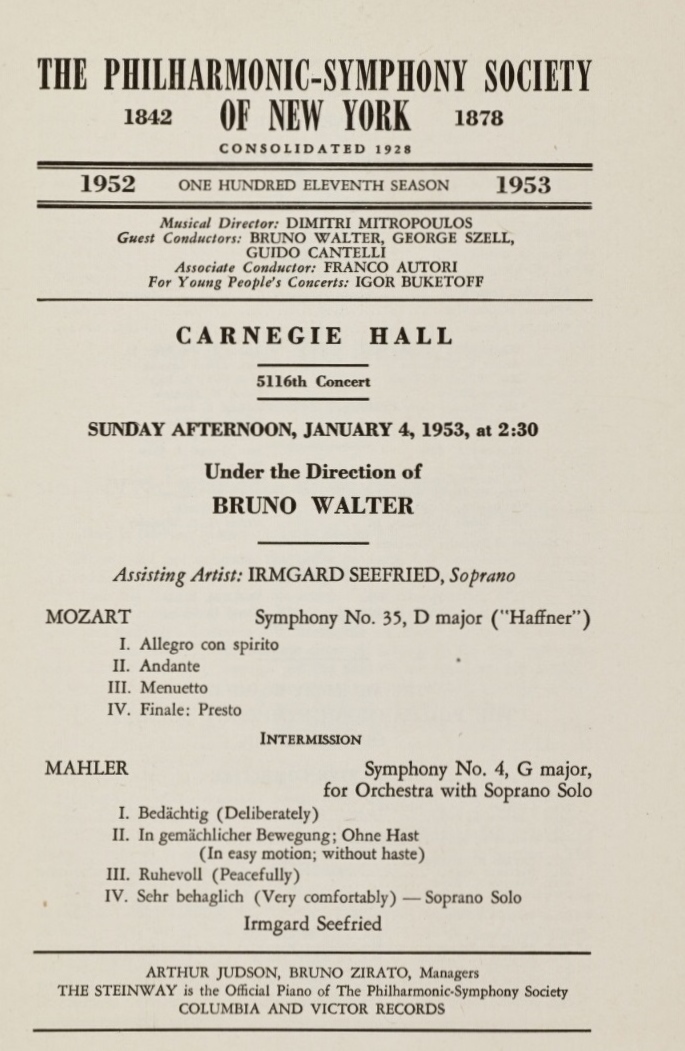

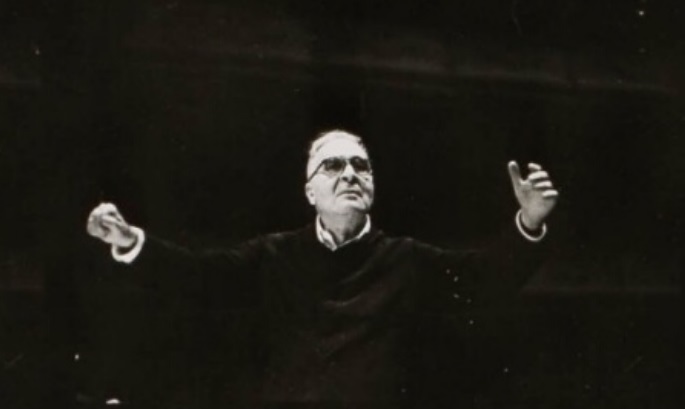
Irmgard Seefried a chanté pour la première fois avec Bruno Walter au Festival de Salzburg 1950, les 23 et 24 août, avec au programme cette même Quatrième Symphonie qu’elle a aussi donnée sous sa direction au Festival d’Edinburgh le 22 août 1951 lors de son tout premier concert avec le NYPO. Sa première apparition à New York a été un récital à Town Hall le 9 décembre 1951 avec Paul Ulanowsky, lors de sa première tournée américaine.
Le concert radiodiffusé du dimanche 4 janvier ne comportait pas les mêmes œuvres que les deux précédents, donnés les 1er et 2 janvier* qui proposaient quatre Lieder avec orchestre de Mahler (Ich bin der Welt abhanden gekommen, Wo die schönen Trompeten blasen, Ich atmet’ einen linden Duft, Wer hat dies Liedlein erdacht), des premières pour le NYPO, dont on n’a hélas pas l’enregistrement, ce qui est d’autant plus regrettable que ce sont les seuls concerts où Seefried et Walter les ont programmées:
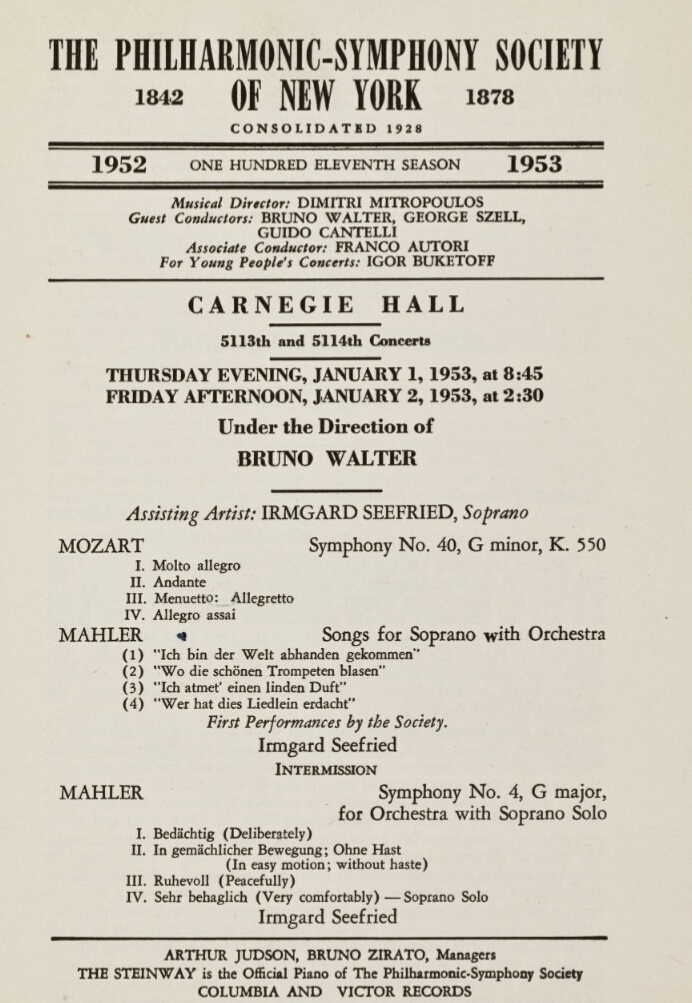
* le concert du 3 janvier 1953 a été dirigé par Franco Autori avec un tout autre programme (Debussy Cathédrale Engloutie, Beethoven Concerto n°5 Eugene Istomin, Sibelius Symphonie n°2).
§§§§§
Seefried a déclaré en 1982 dans une interview: « J‘ai appris de Bruno Walter le style de Mahler. Il m’a dit que Mahler était quelqu’un de très sérieux et de très strict, qu’il fallait le chanter de manière claire et classique, et que pour le Final de la Quatrième, je devais avoir le sentiment d‘être un petit ange chérubin avec une petite trompette, alors que la plupart des sopranos le font comme une petite berceuse ».
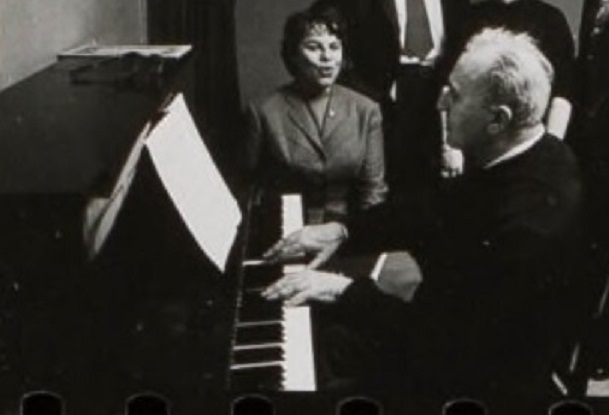
Il reste à expliquer pourquoi, lors du concert du dimanche, la Symphonie n° 35 « Haffner » de Mozart (17′) a été jouée au lieu des quatre mélodies de Mahler (durée totale 15′) qui auraient été le choix logique. L’explication est qu’une séance d’enregistrement était programmée le lundi 5 janvier, dans les Studios Columbia avec la Symphonie « Haffner » et …… « Siegfried Idyll » de Wagner. Il n’est guère étonnant qu’au vu de la charge de travail de l’orchestre en ce début d’année, la séance du 5 janvier ait été peu productive et que l’essentiel de ce qui a été publié provienne de la séance supplémentaire programmée à la hâte le 16 janvier (Mozart Symphonie n°35: 16 janvier; Wagner Siegfried Idyll: 5 & 16 janvier), organisée alors même que l’orchestre donnait ce jour-là en début d’après-midi un concert sous la direction de George Szell.
____________
Irmgard Seefried sang for the first time with Bruno Walter at the 1950 Salzburg Festival, on August 23 and 24, and it was this Fourth Symphony which she also sang under his direction at the Edinburgh Festival on August 22, 1951 for her very first concert with the NYPO. During her first US tour, she was heard at a Town Hall recital with Paul Ulanowsky on December 9, 1951, and this was the first time she sang in New York.
The Sunday January 4 broadcast was not comprised of the same works as the two other ones on January 1 and 2* which proposed four Mahler orchestral Lieder (Ich bin der Welt abhanden gekommen, Wo die schönen Trompeten blasen, Ich atmet’ einen linden Duft, Wer hat dies Liedlein erdacht), first performances with the NYPO, and there is unfortunately no recording thereof, which is all the more regrettable since these were the only concerts at which Seefried and Walter performed them.
* the January 3, 1953 concert was conducted by Franco Autori with an entirely different program (Debussy Cathédrale Engloutie, Beethoven Concerto n°5 Eugene Istomin, Sibelius Symphonie n°2).
§§§§§
In a 1982 interview, Seefried declared: « I learned the style of Mahler from Bruno Walter. He told me that Mahler was somebody very serious, very strict, that he had to be sung in a clear and classical way, and that for the Final movement of the Fourth, I was to have the feeling of being a tiny Cherubino angel with a tiny trumpet, whereas most sopranos do it as a little lullaby« .
There remains to explain why, at the Sunday broadcast concert, Mozart’s Symphony n° 35 « Haffner » (17′) has been played instead of the four Mahler Lieder (total timing:15′) which would have been the logical choice,. The reason was that a recording session had been scheduled on Monday January 5) at the Columbia Studios with the « Haffner » Symphony and…… Wagner’s « Siegfried Idyll ». Small wonder that, in view of the orchesta’s workload on this first week of 1953, the January 5 session had not been very successful, and that the major part of what has been published came from the hastily organized additional session on January 16 (Mozart Symphony n°35: January 16; Wagner Siegfried Idyll: January 5 & 16) scheduled although the orchestra was giving that very day an afternoon concert with George Szell.
Les liens de téléchargement sont dans le premier commentaire. The download links are in the first comment.
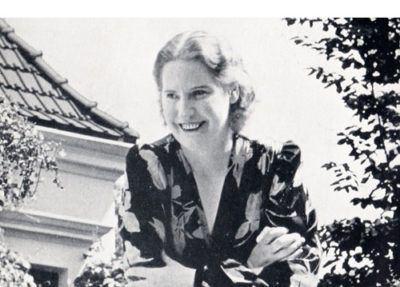
Kirsten Flagstad
Wagner Wesendonck Lieder (Der Engel – Stehe still – Im Treibhaus – Schmerzen – Träume)
Filharmonisk Selskaps Orkester (Orchestra of the Philharmonic Society Oslo)
Dirigent: Øivin Fjeldstad (concert Oslo – Nationaltheatret – Dec. 16, 1951)
33t. Acanta BB 23.189
____
Grieg Haugtussa Op.67 (Det Sing – Veslemöy – Blåbær-Li – Møte – Elsk – Killingdans – Vond Dag – Ved Gjætle-Bekken)
Edwin Mc Arthur, piano ( Los Angeles – April 26, 1950)
33t. RCA LM-2825
Ces deux cycles de mélodies sont ceux que Kirsten Flagstad a le plus donné en concert au cours de sa carrière.
Elle a chanté un nombre incalculable de fois les deux derniers Wesendonck Lieder (Schmerzen, Träume) au cours de ses récitals. Mais ce n’est que le 8 juin 1939 qu’elle a donné pour la première fois le cycle complet lors d’un concert à Zurich à la Villa Wesendonck avec l’Orchestre de la Tonhalle sous la direction de Robert Denzler. Elle l’a ensuite chanté quelque 55 fois, que ce soit dans la version avec piano ou avec orchestre, la dernière fois étant à New-York (Carnegie Hall) le 23 mars 1955 avec l’orchestre « Symphony of the Air » dirigé par Edwin Mc Arthur. Elle a enregistré deux fois le cycle, la première avec Gerald Moore au piano (25 & 26 mai 1948) et la seconde avec le WPO dirigé par Hans Knappertsbusch (Sofiensaal 13 & 15 mai 1956). L’enregistrement de la Radio norvégienne, qui bénéficie de l’accompagnement soigné d’ Øivin Fjeldstad est probablement son meilleur avec orchestre. Son état vocal est notamment meilleur que le 9 mai 1952 avec G. Sébastian au Titania Palast de Berlin, où son timbre, peu de temps avant l’enregistrement de Tristan und Isolde avec Furtwängler, apparaît un peu voilé.
Le cycle Haugtussa Op.67 de Grieg est entré à son répertoire le 13 mars 1940 lors d’un récital à New York (Town Hall) avec le pianiste Edwin Mc Arthur. Elle le chantera ensuite environ 35 fois, la dernière étant à Oslo pour la radio le 16 septembre 1954 avec le pianiste Woldemar Alme. Elle l’a enregistré trois fois avec le pianiste Edwin Mc Arthur: le 27 août 1940 à Los Angeles, le 26 avril 1950, également à Los Angeles, trois jours après un récital donné au Philharmonic Auditorium de cette même ville, et enfin à Londres (22-30 novembre 1956).
En 1950, l’enregistrement de cette œuvre qui lui tenait particulièrement à cœur est d’une très grande chaleur expressive, plus que dans ses deux autres prestations pour le disque.
Ce magnifique cycle composé par Grieg en 1895 ne comporte que huit mélodies. Il raconte le premier déboire amoureux d’une jeune montagnarde, Veslemöy. Les références à la nature des poèmes d’Arne Garborg, auxquelles s’ajoute une pointe de mysticisme, et l’invocation au ruisseau qui conclue le cycle font penser à la « Schöne Müllerin » de Schubert. Si ce chef-d’œuvre est pratiquement oublié de nos jours, c’est probablement à cause de la langue des poèmes, difficilement abordable. Pourtant, Flagstad l’a chanté un peu partout aux Etats-Unis y compris dans des villes moyennes situées hors des circuits habituels des concerts. Avec une traduction, le sens des poèmes est aisé à comprendre.
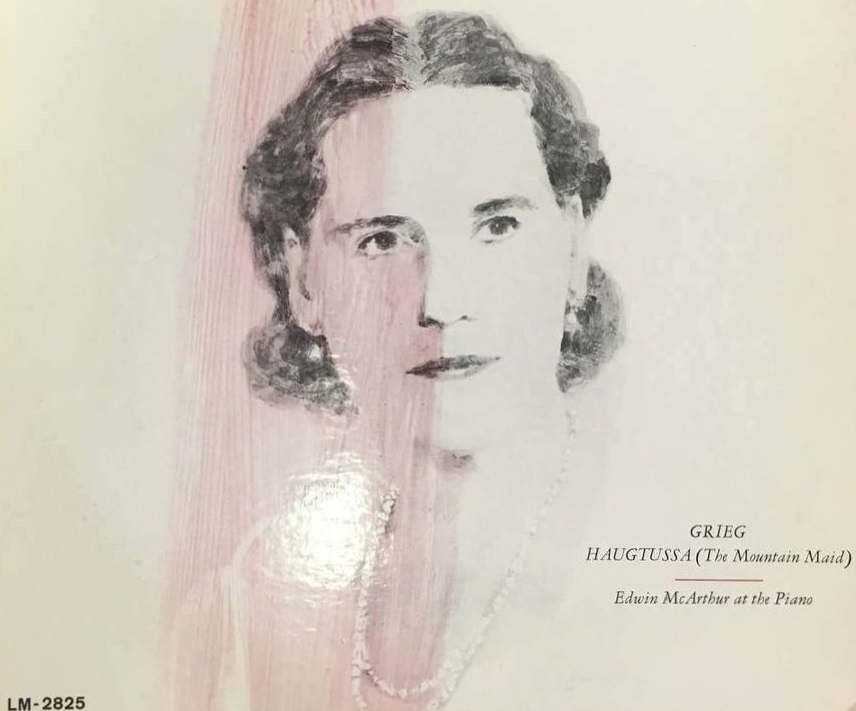
These two Lieder cycles are those of which Kirsten Flagstad gave the most concert performances during her career.
She sang an innumerable number of times the last two Wesendonck Lieder (Schmerzen, Träume) during her recitals. But it is only on June 8, 1939 that she performed the complete cycle for the first time during a concert at the Villa Wesendonck in Zurich with the Tonhalle Orchester conducted by Robert Denzler. She then sang it about 55 times, either in the version with piano or with orchestra, the last time being in New-York (Carnegie Hall) on March 23, 1955 with the « Symphony of the Air Orchestra » conducted by Edwin Mc Arthur. She recorded it twice, the first time with Gerald Moore at the piano (May 25 & 26, 1948) and the second time with the WPO conducted by Hans Knappertsbusch (Sofiensaal May 13 & 15, 1956). The recording made by the Norvegian Radio, with Øivin Fjeldstad’s refined accompaniment is probably her best with an orchestra. Her vocal condition is notably better than on May 9, 1952 with G. Sébastian at the Berlin Titania Palast, where her timbre, not long before the recording of Tristan und Isolde with Furtwängler, sounds slightly veiled.
The cycle Haugtussa Op.67 by Grieg entered her repertoire on March 13, 1940 during a recital in New York (Town Hall) with pianist Edwin Mc Arthur. She then sang it about 35 times, the last one in Oslo as a Radio broadcast on September 16, 1954 with pianist Woldemar Alme. She made three recordings with pianist Edwin Mc Arthur: on August 27, 1940 in Los Angeles, on April 26, 1950, also in Los Angeles, three days after a recital at the Philharmonic Auditorium of that same city, and then in London (November 22-30, 1956).
In 1950, the recording of this work that was especially dear to her, has a very great expressive warmth, more than in her other two studio renditions.
This magnificent cycle composed by Grieg en 1895 is comprised of only eight melodies. It tells the story of the first unhappy love of a mountain maid, Veslemöy. Arne Garborg’s poems make reference to nature, with a touch of mysticism, and the invocation to the brook that ends the cycle makes one think of Schubert’s « Schöne Müllerin ». If this masterpiece is now almost forgotten, it is probably because the language of the poems is not easy of access. However, Flagstad sang it almost everywhere in the United States, included in middle-sized towns far from the usual path of concert tours. With a translation, the meaning of the poems is easy to comprehend.
Les liens de téléchargement sont dans le premier commentaire. The download links are in the first comment.
SONY Classical vient d’annoncer la parution prévue en avril 2022 d’un imposant coffret de 69 CD intitulé « Dimitri Mitropoulos – The Complete RCA and Columbia Album Collection ».
C’est un véritable événement , car l’accessibilité de nombre de ces documents historiques était devenu problématique.
Les détails de la composition du coffret sont donnés ici
______________
SONY Classical has just announced the publication in April 2022 of an important Boxset titled: « Dimitri Mitropoulos – The Complete RCA and Columbia Album Collection ».
This is a great event since many of these historical documents had become hard to find.
The details of its content are given here



